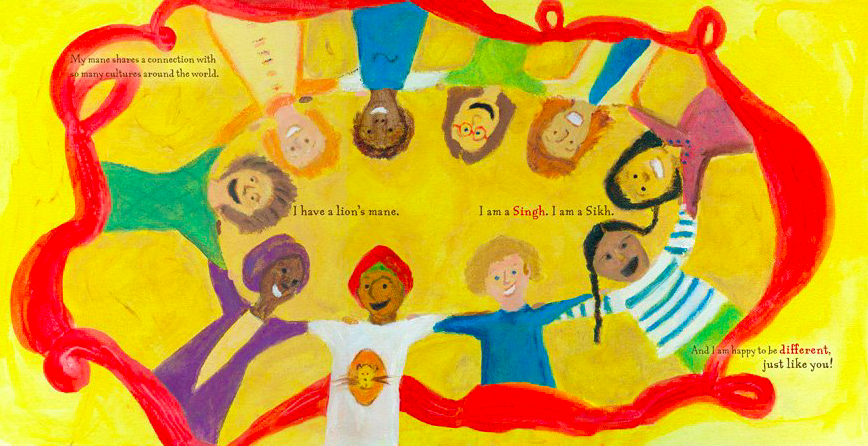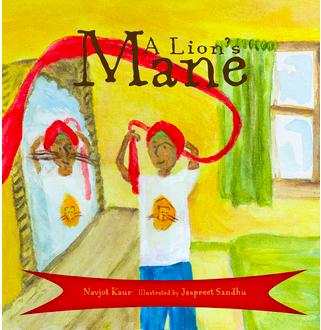
How often did the covers of the books you read as a child have children who looked like you? Did these children’s books offer you a sense of belonging or importance? As our children enter into such a global community, it is clear that having access to authentic literature representing their heritage can only help ease the numerous challenges of peer pressure and elevate self-esteem. Literature is perhaps the strongest avenue to enable us to realize our commonalities while teaching us about the idiosyncratic nature of one another.
This is why I am so excited about the children’s book that promises to be a staple on the shelves of young visionaries. A Lion’s Mane, published in August 2009 by Saffron Press, is written by Navjot Kaur and illustrated by Jaspreet Sandhu. The book encourages children to deepen their understanding of positive self-identity.
In this beautifully illustrated story, young readers journey to cultures around the world to explore the meaning of the Sikh dastaar, or turban. The dastaar is part of the visible identity of the Sikhs, which ensures a Sikh stands out in a crowd, therefore making Sikhs conscious of their personal actions and prepared to defend people in need. The dastaar is used as a metaphor throughout the story and represents nobility, guidance, wisdom and strength. Words like “respect,” “strong” and “loyalty” are written within the vibrant red dastaar on each page and help promote our connections as global citizens, encouraging dialogue around issues of identity.
Historically, the dastaar represents a steadfastness against social tyranny when Guru Gobind Singh ji created the Khalsa to stand up to a hierarchical society and break down caste system. Thus, the dastaar became a crown for Sikhs ensuring that a member of the Khalsa can be recognized in a crowd and will be accountable to the ideal of standing up against oppression and injustice.
This book moves beyond the traditional in several ways. It brings a global perspective to the often misidentified image of the Sikh turban. It is printed on 100% recycled paper as well as displaying an Eco-Libris badge—625 trees were planted for the first edition! In addition, a portion of proceeds from the sale of each book will support Seva Canada’s work to restore sight and prevent blindness in children. By shopping at Saffron Press, you are contributing to a green and ethical cause.
I spoke with the author of A Lion’s Mane, Navjot Kaur, about the book and the challenges she underwent to have this story published.

Tell us about why you wrote this story?
This has been quite a personal journey. The story of A Lion’s Mane began while on an extended leave from teaching to raise my son. After learning of my son’s hearing loss, a disability I had little, if any knowledge of, I became exposed to a whole new culture and the deaf community. My son’s identity became a part of every day conversation and great thought. Given the different respective avenues to consider after his diagnosis—a hearing or non-hearing world—we realized that hearing aids would become a large part of his already visible Sikh identity. I knew that a strong foundation would only strengthen his confidence and sense of who he is in the future. For my husband and I, that foundation meant a positive sense of his Sikh identity which would combine with his hearing-impaired identity, to give him every sense of ability—and the spirit of a true lion going forward. A Lion’s Mane is for the strength I see in him everyday to stand out and be different.
What were some of the challenges you faced in getting this book published?
The experience has been an insightful one. Traditional publishers prefer characters or images that fit the mainstream consumer, understandably given the current economic climate. The Sikh identity is not meant to fit in, it’s meant to stand out. I hope A Lion’s Mane does that and encourages dialogue around the issues of preconceived bias and stereotypes.
Speak to us about positive self-identity? Why is it important?
Children are flooded with information today. I believe in the power of media literacy, giving children the tools to sift through everything they see and hear to create their own opinions. Our identity is constantly being shaped by what we experience. If children are encouraged to talk about what they see, hear, and read, then I think we are contributing to a stronger, more compassionate and respectful global world.
What motivated you to go green with your book?
I have long embraced the values of alternative health care and living as chemical-free as possible. When considering this project, I had to remain true to myself, so going green was an integral decision. I believe it is very much a part of my Sikh identity—sarbat da bhalla going green with A Lion’s Mane is a small way of giving back to the environment we take so much from.
After reading this interview, now consider this: how important is diverse and multicultural literature on the shelves of every library and school? Did you or do your children have access to this type of literature?
Additional Children’s Books Featuring Sikhs
We found a great list over at Kaur Life, check it out!
And we are looking forward to the release of Fauja Singh Keeps Going, in August 2020.

































[…] reaction was to educate the children about what the patka represents. So I shared the story of “A Lion’s Mane” with my son’s Kindergarten […]